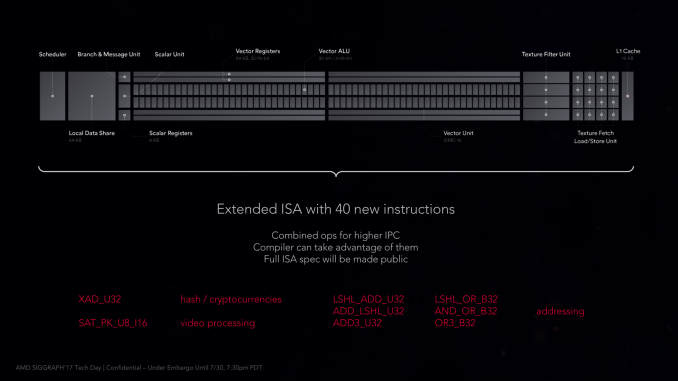The AMD Radeon RX Vega 64 & RX Vega 56 Review: Vega Burning Bright
by Ryan Smith & Nate Oh on August 14, 2017 9:00 AM ESTThe Vega Architecture: AMD’s Brightest Day
From an architectural standpoint, AMD’s engineers consider the Vega architecture to be their most sweeping architectural change in five years. And looking over everything that has been added to the architecture, it’s easy to see why. In terms of core graphics/compute features, Vega introduces more than any other iteration of GCN before it.
Speaking of GCN, before getting too deep here, it’s interesting to note that at least publicly, AMD is shying away from the Graphics Core Next name. GCN doesn’t appear anywhere in AMD’s whitepaper, while in programmers’ documents such as the shader ISA, the name is still present. But at least for the purposes of public discussion, rather than using the term GCN 5, AMD is consistently calling it the Vega architecture. Though make no mistake, this is still very much GCN, so AMD’s basic GPU execution model remains.
So what does Vega bring to the table? Back in January we got what has turned out to be a fairly extensive high-level overview of Vega’s main architectural improvements. In a nutshell, Vega is:
- Higher clocks
- Double rate FP16 math (Rapid Packed Math)
- HBM2
- New memory page management for the high-bandwidth cache controller
- Tiled rasterization (Draw Stream Binning Rasterizer)
- Increased ROP efficiency via L2 cache
- Improved geometry engine
- Primitive shading for even faster triangle culling
- Direct3D feature level 12_1 graphics features
- Improved display controllers
The interesting thing is that even with this significant number of changes, the Vega ISA is not a complete departure from the GCN4 ISA. AMD has added a number of new instructions – mostly for FP16 operations – along with some additional instructions that they expect to improve performance for video processing and some 8-bit integer operations, but nothing that radically upends Vega from earlier ISAs. So in terms of compute, Vega is still very comparable to Polaris and Fiji in terms of how data moves through the GPU.
Consequently, the burning question I think many will ask is if the effective compute IPC is significantly higher than Fiji, and the answer is no. AMD has actually taken significant pains to keep the throughput latency of a CU at 4 cycles (4 stages deep), however strictly speaking, existing code isn’t going to run any faster on Vega than earlier architectures. In order to wring the most out of Vega’s new CUs, you need to take advantage of the new compute features. Note that this doesn’t mean that compilers can’t take advantage of them on their own, but especially with the datatype matters, it’s important that code be designed for lower precision datatypes to begin with.











213 Comments
View All Comments
DanNeely - Tuesday, August 15, 2017 - link
I've been running BOINC on my GPUs since the GTX 260. With a half dozen cards totaling about 20-25 years of operation I've had 1 card fail at the 2 year mark (GT 560), and one fan fail after about a year (HD 5850). The others all lasted 3-4 years until newer gaming purchases pushed them out of my slowed box and into retirement.Otritus - Monday, August 14, 2017 - link
While they dont have the funds to truly compete with nvidia I do see what you mean because in the gpu sector it seems rtg is focused on adding features and not increasing performance while decreasing power consumption. Polaris had more perf/per watt than vega, and I hate that regression from amd.Aldaris - Monday, August 14, 2017 - link
Why would anyone choose to lag behind? It's obviously not a choice.milkod2001 - Monday, August 14, 2017 - link
Vega is indeed disappointment and now we know that officially. The worst part is that NV don't have to lower its current GPU prices nor rush next gen GPU's.When can we expect next gen GPU from both camps?
TheinsanegamerN - Monday, August 14, 2017 - link
Volta will come out with a 30-35% increase per category, and will sell for most of its reign unopposed. Navi will eventually come out, just before volta's replacement launches.AMD fell behind, and now must either rush a new generation or lag behind for half a year to get out of their current position.
Aldaris - Monday, August 14, 2017 - link
Well, we don't know that officially because that's an opinion. Looks to me like NV do have to lower prices.mapesdhs - Monday, August 14, 2017 - link
Based on what? In the UK, the 1080 is 100 UKP cheaper than the Vega64/Air, while the Vega64/Liquid costs more than a 1080 Ti. NV doesn't have to do anything, at least not re the 1080 anyway. As for the 1070, perhaps a different matter, we'll see what happens with final retail pricing.If you're in the US though and the 64 really is $500, well maybe it might be more attractive if you're not bothered by the power/noise issues. Alas, outside the US the real consumer pricing is more of a mess.
vladx - Monday, August 14, 2017 - link
AnandTech is turning into a joke with catchphrases like "Vega Burning Bright" or "The Vega Architecture: AMD’s Brightest Day". Quit trying to polish a turd and call Vega for what it really is, a crappy product that was released way too late, is slower than the competition on neutral games and extremely inefficient as well.I knew AT had a bias for AMD and Apple, but this is really getting ridiculous.
casperes1996 - Monday, August 14, 2017 - link
Last comment section I read repeatedly stated how anti-AMD AnandTech is... Go figure.nevcairiel - Monday, August 14, 2017 - link
Something that burns bright typically puts out a lot of excess energy (heat) and eventually burns out. :p